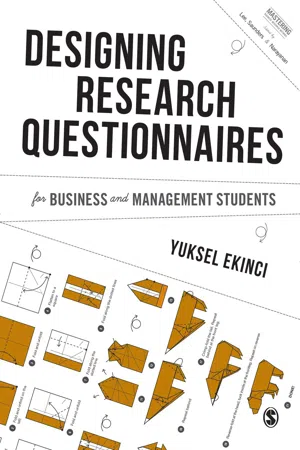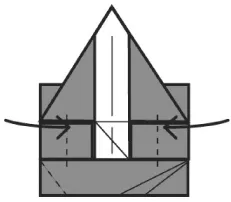
eBook - ePub
Designing Research Questionnaires for Business and Management Students
- 184 pages
- English
- ePUB (mobile friendly)
- Available on iOS & Android
eBook - ePub
Designing Research Questionnaires for Business and Management Students
About this book
In Designing Research Questionnaires, Yuksel Ekinci guides you through origins, types of questionnaire, basic components, types of questions and properties of measurement scales, how to design a questionnaire, sequence of questions, layout decisions and pilot testing, examples and strengths and limitations.
Ideal for Business and Management students reading for a Master's degree, each book in the series may also serve as reference books for doctoral students and faculty members interested in the method.
Part of SAGE's Mastering Business Research Methods Series, conceived and edited by Bill Lee, Mark N. K. Saunders and Vadake K. Narayanan and designed to support researchers by providing in-depth and practical guidance on using a chosen method of data collection or analysis.
Ideal for Business and Management students reading for a Master's degree, each book in the series may also serve as reference books for doctoral students and faculty members interested in the method.
Part of SAGE's Mastering Business Research Methods Series, conceived and edited by Bill Lee, Mark N. K. Saunders and Vadake K. Narayanan and designed to support researchers by providing in-depth and practical guidance on using a chosen method of data collection or analysis.
Frequently asked questions
Yes, you can cancel anytime from the Subscription tab in your account settings on the Perlego website. Your subscription will stay active until the end of your current billing period. Learn how to cancel your subscription.
No, books cannot be downloaded as external files, such as PDFs, for use outside of Perlego. However, you can download books within the Perlego app for offline reading on mobile or tablet. Learn more here.
Perlego offers two plans: Essential and Complete
- Essential is ideal for learners and professionals who enjoy exploring a wide range of subjects. Access the Essential Library with 800,000+ trusted titles and best-sellers across business, personal growth, and the humanities. Includes unlimited reading time and Standard Read Aloud voice.
- Complete: Perfect for advanced learners and researchers needing full, unrestricted access. Unlock 1.4M+ books across hundreds of subjects, including academic and specialized titles. The Complete Plan also includes advanced features like Premium Read Aloud and Research Assistant.
We are an online textbook subscription service, where you can get access to an entire online library for less than the price of a single book per month. With over 1 million books across 1000+ topics, we’ve got you covered! Learn more here.
Look out for the read-aloud symbol on your next book to see if you can listen to it. The read-aloud tool reads text aloud for you, highlighting the text as it is being read. You can pause it, speed it up and slow it down. Learn more here.
Yes! You can use the Perlego app on both iOS or Android devices to read anytime, anywhere — even offline. Perfect for commutes or when you’re on the go.
Please note we cannot support devices running on iOS 13 and Android 7 or earlier. Learn more about using the app.
Please note we cannot support devices running on iOS 13 and Android 7 or earlier. Learn more about using the app.
Yes, you can access Designing Research Questionnaires for Business and Management Students by Yuksel Ekinci,Author in PDF and/or ePUB format, as well as other popular books in Business & R&D. We have over one million books available in our catalogue for you to explore.
Information
4 Conducting Research with Questionnaires Part I – Designing Questionnaires

Introduction
Successful questionnaires must be compiled to produce reliable, valid responses and to accomplish the research objectives. Reliable and valid information is obtained by asking the right people the right questions in a manner that appears sensible to respondents. Too often, the questionnaire does not work when the designer sees the questions and layout only from his own point of view rather than that of the respondents. When a poor questionnaire is produced, the designer may have thought about the objectives of the study and the layout but have given insufficient consideration to the questionnaire wording. This type of approach produces questions that are too long, too difficult to answer and unnecessarily complicated for respondents.
The purpose of this chapter is to introduce the design principles applicable to all types of questionnaires, whether administered by mail, telephone, face to face or via the internet. This is achieved by introducing a step-by-step approach illustrated with examples from questionnaires that have been successfully applied to management research. By the end of this chapter, you should be ready to produce a draft questionnaire for your study.
Questionnaire Design Process
The questionnaire must be designed with the specific research objectives in mind. The style in which questions are asked varies from one person to another and from one research topic to another. Therefore, the vast majority of questionnaires is, at least in part, custom made. Because research objectives are unique to every study and questions are influenced by them as well as by data collection methods, there is no standard procedure in the development of a ‘successful’ questionnaire. In addition to asking the right questions to the right people, you must also consider the question styles and design layout. Therefore, questionnaire design is often considered an imperfect science. Having said that, there are logical steps and wording principles that you need to follow in order to produce a well-structured questionnaire. Figure 4.1 introduces the questionnaire process model for design.

Figure 4.1 The process and principles of questionnaire design
As shown in Figure 4.1, you must first establish the type of data required and the target respondent for data collection. Your decision at this stage will be assisted by your research question and theoretical framework and by determining the most appropriate questionnaire administration methods (mail, face to face, telephone or online). At stage two, a draft questionnaire can be produced, paying attention to the types of questions, wording, possible use of measurement scales, and data analysis methods.
At stage three, you should consider the sequence of questions and the questionnaire layout. The questionnaire length, introduction and instructions should also be established at this stage. Finally, the questionnaire must be pilot tested on a small sample of respondents to check for errors, comprehensibility, knowledge and the ability and willingness to respond. You should assess the reliability and validity of the scaled-response questions with the data collected from your target respondents. If changes are required to the questionnaire as a result of the pilot test, these should be reported in your methodology chapter. You should include a blank copy of both the first draft of the questionnaire (before pilot testing) and the revised questionnaire (after pilot testing) as appendices to your thesis or business report to enable the reader to follow the changes made. The principles of questionnaire design applied to each of these stages will be explained in greater detail in this chapter and in Chapter 4, Part II.
Step 1: Determine the required information and target respondent
The most challenging task in questionnaire design is to determine what information is required from respondents. Various techniques and thought processes are available to identify the research problem and information goals. Conducting literature reviews and preliminary interviews with experts and respondents can help. Poor judgement and lack of thought at this stage may result in the questionnaire and subsequent data being irrelevant to the research topic. Furthermore, the question content and instructions must be suitable for the scope of the study and of interest to the respondents. For example, it would be unsuitable to ask an IT manager how the company’s human resources management policy is developed and implemented. Also, questions and directives that are relevant to one group such as executive managers may not be relevant to others (e.g. consumers, employees). Because mail and online questionnaires are self-completed, instructions should be clear and questions kept simple. Interviewer-administered questionnaires (face to face) can be composed of more complex questions and instructions can be implemented because of the greater interaction between interviewer and respondent. Having said that, questionnaires administered by telephone interview should contain short questions as respondents may find long questions difficult to understand during a phone conversation.
To identify the most essential and relevant questions, you should revisit your research objectives and theoretical framework. Depending on your research problem and the research approach, the research objectives should be further revised to identify more specific research questions because this will endeavour to:
- Ensure that the questionnaire covers all the necessary points.
- Help to develop information goals which will eventually be converted into more specific questions.
- Determine the types of questions suitable for target respondents, research hypothesis, questionnaire administration methods and data analysis methods.
Boxes 4.1 and 4.2 illustrate how the information goals are determined and questions matched to the research objectives. It also describes the theoretical framework and the research approach used for hypothesis testing as well as for an exploratory study.
After deciding what information is required, you can move on to step 2.
Box 4.1 Example to determine the required information and questions for a hypothesis-testing study
The process of hypothesis testing is to determine the type of information required and to formulate the most essential questions required for the study. First, you should identify the research question, research objectives, and a theoretical framework that enables you to develop specific questions. Next, the definition of constructs and formulation of the research hypothesis should be stated before moving on to a draft questionnaire.
This example describes the aim of the study, which is to investigate the influence of consumer-based brand equity on consumer loyalty within UK department stores. As this study proposes testing of the research hypotheses, it will adopt a deductive research approach and employ a highly structured questionnaire. The main research question is:
‘Does consumer-based brand equity influence consumer loyalty within UK department stores?’
This type of thought process helps drill down the topic and identifies other sub-research questions related to the main research question. They are:
What is meant by consumer-based brand equity?Is consumer-based brand equity a uni-dimensional or multidimensional construct?If it is multidimensional, what are the key dimensions (components) of consumer-based brand equity?What is meant by consumer loyalty?Is consumer loyalty a uni-dimensional or multidimensional construct?If it is multidimensional, what are the key dimensions (components) of consumer loyalty?Does the perception of consumer-based brand equity and consumer loyalty differ across consumer groups and department stores?
Investigation of the sub-research questions requires information as to (1) how to measure consumer-based brand equity, (2) how to measure consumer loyalty in the retail industry, and (3) whether consumer-based brand equity and consumer loyalty differ across different consumer groups or different department stores. A review of branding literature suggests that consumer-based brand equity is an image-based construct with multiple dimensions (Aaker, 1996). One of the most relevant models of consumer-based brand equity applied in the service industry suggests that brand equity has five dimensions: physical quality, staff behaviour, self-congruence, brand identification and lifestyle congruence (Nam et al., 2011). Physical quality is the image projected by the design, equipment, facilities and materials of the department stores. Staff behaviour is the image projected by competence, helpfulness, friendliness and responsiveness of the employees of the department stores.
Self-congruence is the degree to which the self-concept of the consumer coincides with the depar...
Table of contents
- Cover
- Table of Contents
- Editors’ Introduction to the Mastering Business Research Methods Series
- About the Series Editors
- About the Author
- Introduction
- Understanding Research Questionnaires
- Basic Components of Research Questionnaires
- Conducting Research with Questionnaires: Part I – Designing Questionnaires
- Conducting Research with Questionnaires: Part II – Designing Questionnaires
- Examples of Research Questionnaires
- Conclusions
- Glossary of Key Terms